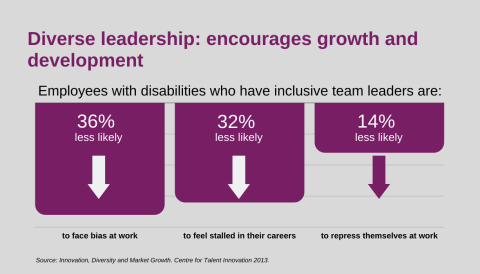Event wrap: Towards inclusive growth: enabling career progression for employees with disability to vitalise organisational success
The benefits of employing people with disability are clear.
Research shows people with disability are:
- more productive
- have a better safety record
- are more reliable
- are more cost-effective to employ1.
Australian employers are seeing the benefits of employing people with disability. They are tapping into the diverse skills and experiences they have to offer. Many organisations are removing barriers when they hire and welcome new employees.
Yet many workplaces do not give those employees the chance to progress their career.
A lack of opportunity can stall growth and development. Employers risk wasting the potential of employees with disability.
JobAccess presented a series of webinars to address these challenges.
Over 40 employees from more than 25 organisations joined the events. The seminars gave practical strategies to support employees with disability.
Room for disability representation in leadership positions
There is a growing drive for diversity in leadership positions. Yet employees with disability are often overlooked. This means employers are missing important viewpoints. Insights that could improve decision making, financial performance, and culture.
Over 60% of Australians with disability experience limits in the workplace. These include ‘being restricted in the type of job,’ changing jobs or getting a preferred job2.
There are many ways to make a change. Employees with disability must have access to career development programs.

Graph showing how employees with disabilities benefit from inclusive team leaders. They are less likely to face bias at work. They are less likely to feel stalled in their careers and repress themselves at work3.
A team approach
Everyone is responsible for changing the systems that limit people with disability. Leaders have the power to make disability inclusion a priority. They can hold the workplace accountable to diversity and inclusion goals.
Setting good policies, hiring goals, and performance metrics is a start. Beyond that, employers can focus on improving accessibility.
Adjustments are covered in the Disability Discrimination Act 1992 (DDA). If an employer is aware of an employee’s disability, they must provide a ‘reasonable adjustment.' That means they must make the changes needed for the employee to do their job.
Employers can get assistance to cover the cost of workplace adjustments. For more information, visit the Australian Government’s Employment Assistance Fund (EAF).
Workplaces can revisit the adjustments when an employee’s role changes. This flexibility allows people with disability to pursue new opportunities.
Promoting internal roles can also provide career development for employees with disability. When advertising internal roles, employers can rethink the job description. Focus on what a person needs to be able to do and achieve in that position. That way employers will attract people with diverse skillsets.
Make it happen in the workplace
There are many ways employers can make career opportunities more accessible.
Disability inclusion goes beyond employing people. Their skills, experiences and perspectives need to be valued. Being open about disability in the workplace will make it safer for people to talk about their needs.
Another strategy is to decide why disability inclusion is important for your workplace. Create a business case that shows the value of diversity. Then take the steps needed to support all employees.
For more information, speak to a friendly JobAccess advisor. They offer advice about supporting employees with disability in the workplace. Contact JobAccess on1800 464 800.
The JobAccess Employer Engagement team (NDRC) works with employers to help them improve a workplace’s disability confidence by removing barriers. They offer free 12-month partnerships.
The NDRC offers advice, tips and plans to support people with disability. Information covers all stages of employment – from hiring, to retaining and progressing careers.
Sources:
1: Graffam J, Shinkfield A, Smith K and Polzin, U 2002, Employer benefits and costs of employing a person with a disability. Journal of Vocational Rehabilitation, vol. 17, no. 4, p. 251-263; Australian Safety and Compensation Council, 2007. Are People with Disability at Risk at Work? A Review of the Evidence, ASSC, Canberra, Du Paul University 2007; People with disabilities: A new model of productive labor: https://web.archive.org.au/awa/20220816104504mp_/https:/scholars.unh.edu/cgi/viewcontent.cgi?referer=&httpsredir=1&article=1017&context=hospman_facpub.
2: People with disability in Australia. Australian Institute of Health and Welfare. Sept 2019
3: Innovation, Diversity and Market Growth. Centre for Talent Innovation 2013. https://coqual.org/wp-content/uploads/2020/09/31_innovationdiversityandmarketgrowth_keyfindings-1.pdf
Useful Downloads
Related pages
Last updated:
